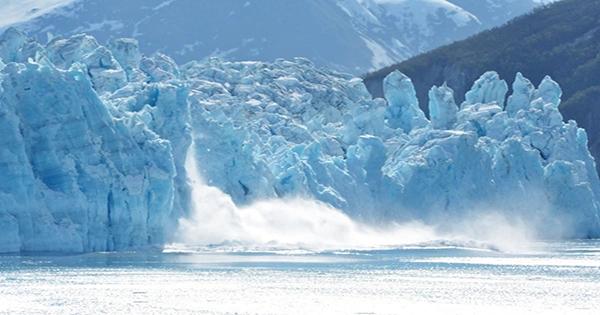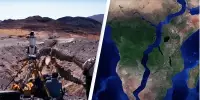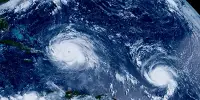Researchers in Antarctica witnessed a glacier’s front collapse while they recorded data that “went off the scale.” They recorded “internal” underwater tsunamis as tall as a house in addition to seeing disturbances on the ocean surface, a phenomenon that has previously been overlooked in theories of ocean mixing and computer simulations.
The group, coordinated by researchers from the British Antarctic Survey (BAS), reports its findings in the journal Science Advances today.
Internal tsunamis play a significant role in ocean mixing, which has an impact on ocean life, temperatures at various depths, and the amount of ice that the ocean may melt. In Antarctica, glacier-filled valleys are used to transport ice to the coast. While some ice melts into the ocean, a significant amount breaks off forming icebergs, which can be as large as countries or as small as individual pieces.
On the Antarctic Peninsula, the William Glacier’s front suddenly fragmented into hundreds of tiny fragments as a team on board the BAS research ship RRS James Clark Ross took measurements of the ocean nearby.
The William Glacier normally experiences one or two significant calving episodes every year, and the researchers calculated that this particular one, with the glacier’s front towering 40 meters above sea level, broke off some 78,000 square meters of ice—roughly the size of 10 football fields.
The water temperature before it broke away was warmer below 50 meters and colder between 50 and 100 meters. This underwent a significant change during calving, with the temperature being much more uniform at all depths.
Professor Michael Meredith, the study’s lead author and the director of BAS’s Polar Oceans division, stated, “This was incredible to observe, and we were fortunate to be in the right place at the right time. Many glaciers converge into the ocean, where their tips frequently break off as icebergs. Although it can produce large waves at the surface, we now know that it can also produce waves deep within the water. These internal waves cause the sea to mix as they break, which has an impact on the marine life there as well as how warm the water is at different depths and how much ice it may melt. We need to know this in order to better understand.
“The distribution of nutrients in the water is affected by ocean mixing, which has an impact on ecosystems and biodiversity. We assumed that wind and tides were the key factors causing this mixing during the summer, but it never dawned on us that iceberg calving could result in internal tsunamis that would stir things up so thoroughly.”
At the time of the calving incident, which was recorded by a Sky News team on board at the time, Professor James Scourse, Head of the Department of Earth and Environmental Sciences at the University of Exeter, was the Principal Scientific Officer on the RRS James Clark Ross.
Dr. Katy Sheen of the Centre for Geography and Environmental Science on the Penryn Campus and candidate Tobias Ehmen from Exeter have played major roles in the evaluation of the data collected.
“Often the most important and exciting discoveries in science are serendipitous—you happen to be at the right place at the right time with the right instruments and the right people—and because you know it’s important you just make sure you tweak the work plan to make the most of what nature has offered you,” Professor Scourse said. “We did that in Börgen Bay back in January 2020 and as a result we’ve produced the first data on a process that has implications for how fast the ocean is able to melt the ice sheets. This has implications for all of us.”
Tsunamis are created by geophysical occurrences when water is rapidly displaced, such as an earthquake or landslide, in contrast to the waves caused by wind and tides.
A few locations have reported internal tsunamis brought on by landslides. Since there are so many glaciers there that are constantly calving, no one had realized until recently that they were occurring all over Antarctica. Other glacier-covered areas, like Greenland and other parts of the Arctic, are probably also impacted.
This coincidental finding and comprehension are crucial because as global warming progresses, glaciers will continue to retreat and calve more frequently. The number of internal tsunamis produced and the mixing they induce could certainly rise as a result.
The computer models we now use to forecast potential events surrounding Antarctica do not take this process into account. This finding alters our perception of the mixing of the seas surrounding Antarctica and advances our understanding of the implications for the environment, the ecosystem, and sea level rise.
Professor Meredith remarked, “Our fortuitous timing shows how much more we need to learn about these remote environments and how they matter for our planet.”















